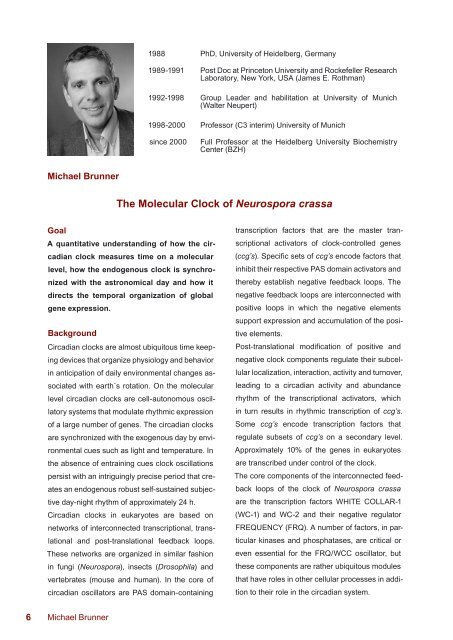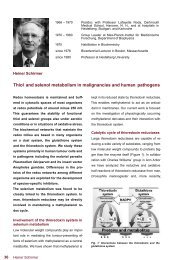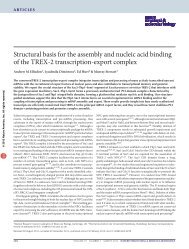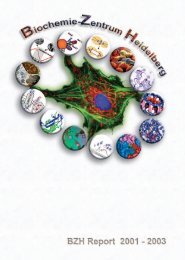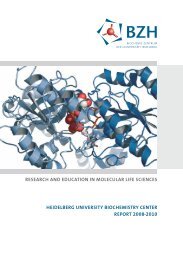Biochemie-Zentrum der Universität Heidelberg (BZH)
Biochemie-Zentrum der Universität Heidelberg (BZH)
Biochemie-Zentrum der Universität Heidelberg (BZH)
Create successful ePaper yourself
Turn your PDF publications into a flip-book with our unique Google optimized e-Paper software.
Michael Brunner<br />
Goal<br />
A quantitative un<strong>der</strong>standing of how the cir-<br />
cadian clock measures time on a molecular<br />
level, how the endogenous clock is synchro-<br />
nized with the astronomical day and how it<br />
directs the temporal organization of global<br />
gene expression.<br />
Background<br />
Circadian clocks are almost ubiquitous time keeping<br />
devices that organize physiology and behavior<br />
in anticipation of daily environmental changes associated<br />
with earth`s rotation. On the molecular<br />
level circadian clocks are cell-autonomous oscillatory<br />
systems that modulate rhythmic expression<br />
of a large number of genes. The circadian clocks<br />
are synchronized with the exogenous day by environmental<br />
cues such as light and temperature. In<br />
the absence of entraining cues clock oscillations<br />
persist with an intriguingly precise period that creates<br />
an endogenous robust self-sustained subjective<br />
day-night rhythm of approximately 24 h.<br />
Circadian clocks in eukaryotes are based on<br />
networks of interconnected transcriptional, translational<br />
and post-translational feedback loops.<br />
These networks are organized in similar fashion<br />
in fungi (Neurospora), insects (Drosophila) and<br />
vertebrates (mouse and human). In the core of<br />
circadian oscillators are PAS domain-containing<br />
6 Michael Brunner<br />
1988 PhD, University of <strong>Heidelberg</strong>, Germany<br />
1989-1991 Post Doc at Princeton University and Rockefeller Research<br />
Laboratory, New York, USA (James E. Rothman)<br />
1992-1998 Group Lea<strong>der</strong> and habilitation at University of Munich<br />
(Walter Neupert)<br />
1998-2000 Professor (C3 interim) University of Munich<br />
since 2000 Full Professor at the <strong>Heidelberg</strong> University Biochemistry<br />
Center (<strong>BZH</strong>)<br />
The Molecular Clock of Neurospora crassa<br />
transcription factors that are the master transcriptional<br />
activators of clock-controlled genes<br />
(ccg’s). Specific sets of ccg’s encode factors that<br />
inhibit their respective PAS domain activators and<br />
thereby establish negative feedback loops. The<br />
negative feedback loops are interconnected with<br />
positive loops in which the negative elements<br />
support expression and accumulation of the positive<br />
elements.<br />
Post-translational modification of positive and<br />
negative clock components regulate their subcellular<br />
localization, interaction, activity and turnover,<br />
leading to a circadian activity and abundance<br />
rhythm of the transcriptional activators, which<br />
in turn results in rhythmic transcription of ccg’s.<br />
Some ccg’s encode transcription factors that<br />
regulate subsets of ccg’s on a secondary level.<br />
Approximately 10% of the genes in eukaryotes<br />
are transcribed un<strong>der</strong> control of the clock.<br />
The core components of the interconnected feedback<br />
loops of the clock of Neurospora crassa<br />
are the transcription factors WHITE COLLAR-1<br />
(WC-1) and WC-2 and their negative regulator<br />
FREQUENCY (FRQ). A number of factors, in particular<br />
kinases and phosphatases, are critical or<br />
even essential for the FRQ/WCC oscillator, but<br />
these components are rather ubiquitous modules<br />
that have roles in other cellular processes in addition<br />
to their role in the circadian system.


